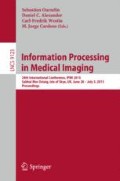Abstract
In this work we propose a novel Gaussian process-based spatio-temporal model of time series of images. By assuming separability of spatial and temporal processes we provide a very efficient and robust formulation for the marginal likelihood computation and the posterior prediction. The model adaptively accounts for local spatial correlations of the data, and the covariance structure is effectively parameterised by the Kronecker product of covariance matrices of very small size, each encoding only a single direction in space. We provide a simple and flexible framework for within- and between-subject modelling and prediction. In particular, we introduce the Hoffman-Ribak method for efficient inference on posterior processes and its uncertainty. The proposed framework is applied in the context of longitudinal modelling in Alzheimer’s disease. We firstly demonstrate the advantage of our non-parametric method for modelling of within-subject structural changes. The results show that non-parametric methods demonstrably outperform conventional parametric methods. Then the framework is extended to optimize complex parametrized covariate kernels. Using Bayesian model comparison via marginal likelihood the framework enables to compare different hypotheses about individual change processes of images.
G. Ziegler—Joint first author.
Data used in preparation of this article were obtained from the Alzheimer’s Disease Neuroimaging Initiative (ADNI) database (http://adni.loni.usc.edu/). As such, the investigators within the ADNI contributed to the design and implementation of ADNI and/or provided data but did not participate in analysis or writing of this report.
Access this chapter
Tax calculation will be finalised at checkout
Purchases are for personal use only
Notes
- 1.
For simplicity we focus on an even sampling across spatial directions, even though the generalization of the proposed model to the uneven case is straightforward.
References
Ashburner, J., Friston, K.: Unified segmentation. NeuroImage 26, 839–851 (2005)
Ashburner, J., Ridgway, G.: Symmetric diffeomorphic modeling of longitudinal structural MRI. Frontiers Neurosci. 6(197) (02 2013)
Davis, B.C., Fletcher, P.T., Bullitt, E., Joshi, S.C.: Population shape regression from random design data. IJCV 90(2), 255–266 (2010)
Flandin, G., Penny, W.D.: Bayesian fMRI data analysis with sparse spatial basis function priors. NeuroImage 34(3), 1108–1125 (2007)
Friston, K.J., Holmes, A., Worsley, K.J.: Statistical parametric maps in functional imaging: a general linear approach. Hum. Brain Mapp. 2, 189–210 (1995)
Gelfand, A., Fuentes, M., Guttorp, P., Diggle, P.: Handbook of Spatial Statistics. Chapman & Hall/CRC Handbooks of Modern Statistical Methods. Taylor & Francis, London (2010)
Harrison, L.M., Green, G.G.: A Bayesian spatiotemporal model for very large data sets. NeuroImage 50(3), 1126–1141 (2010)
Hoffman, Y., Ribak, E.: Constrained realizations of Gaussian fields -a simple algorithm. Astrophys. J. Lett. 380, L5–L8 (1991)
Lorenzi, M., Ayache, N., Frisoni, G.B., Pennec, X.: The Alzheimer’s disease neuroimaging initiative: mapping the effects of A\(\beta \) \(_\text{1 }-\text{42 }\) levels on the longitudinal changes in healthy aging: hierarchical modeling based on stationary velocity fields. In: Fichtinger, G., Martel, A., Peters, T. (eds.) MICCAI 2011, Part II. LNCS, vol. 6892, pp. 663–670. Springer, Heidelberg (2011)
Niethammer, M., Huang, Y., Vialard, F.-X.: Geodesic regression for image time-series. In: Fichtinger, G., Martel, A., Peters, T. (eds.) MICCAI 2011, Part II. LNCS, vol. 6892, pp. 655–662. Springer, Heidelberg (2011)
Rasmussen, C.E., Williams, C.K.I.: Gaussian Processes for Machine Learning. The MIT Press, Cambridge (2005)
Stegle, O., Lippert, C., Mooij, J.M., et al.: Efficient inference in matrix-variate gaussian models with iid observation noise. In: Shawe-Taylor, J., Zemel, S., Bartlett, P.L., Pereira, F.C.N., Weinberger, K.Q. (eds.) Advances in Neural Information Processing Systems 24, pp. 630–638. Second Life, Granada (2011)
Ziegler, G., Ridgway, G.R., Dahnke, R., Gaser, C.: Individualized Gaussian process-based prediction and detection of local and global gray matter abnormalities in elderly subjects. NeuroImage 97, 333–348 (2014)
Acknowledgements
Marco Lorenzi is grateful to Prof. John Ashburner, for his help in finalizing this work, and to Dr. Richard Turner, for his precious suggestions on the train toward London. Sebastien Ourselin receives funding from the EPSRC (EP/H046410/1, EP/J020990/1, EP/K005278), the MRC (MR/J01107X/1), the EU-FP7 project VPH-DARE@IT (FP7-ICT-2011-9-601055), the NIHR Biomedical Research Unit (Dementia) at UCL and the National Institute for Health Research University College London Hospitals Biomedical Research Centre (NIHR BRC UCLH/UCL High Impact Initiative- BW.mn.BRC10269). Gabriel Ziegler is supported in part by the German Academic Exchange Service (DAAD). The Wellcome Trust Centre for Neuroimaging is supported by core funding from the Wellcome Trust [grant number 091593/Z/10/Z].
Author information
Authors and Affiliations
Corresponding author
Editor information
Editors and Affiliations
Rights and permissions
Copyright information
© 2015 Springer International Publishing Switzerland
About this paper
Cite this paper
Lorenzi, M., Ziegler, G., Alexander, D.C., Ourselin, S. (2015). Efficient Gaussian Process-Based Modelling and Prediction of Image Time Series. In: Ourselin, S., Alexander, D., Westin, CF., Cardoso, M. (eds) Information Processing in Medical Imaging. IPMI 2015. Lecture Notes in Computer Science(), vol 9123. Springer, Cham. https://doi.org/10.1007/978-3-319-19992-4_49
Download citation
DOI: https://doi.org/10.1007/978-3-319-19992-4_49
Published:
Publisher Name: Springer, Cham
Print ISBN: 978-3-319-19991-7
Online ISBN: 978-3-319-19992-4
eBook Packages: Computer ScienceComputer Science (R0)

